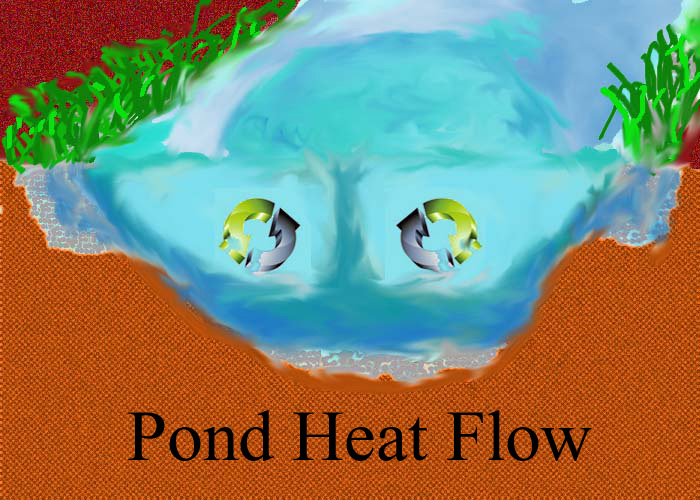Froggie,
I know you lack the ability to control your temperature where some hard-hearted call this cold blooded. You gain all of your energy directly from the pond. We need to understand how the heating/cooling system works so that you are not too warm in the summer or too cold in the winter. Excess heat is often the problem.
The sun produces 1,000 Watts of energy per square meter. Oh wow! That is over 800 Kcals per hour/m2. The pond takes huge meals every hour from the sun. It is by far the most energy entering the pond where chemical energy (food) in the form of fertilizer is next. So we need to fix the furnace and turn on the water conditioner.
Plants mitigate solar heating. If you notice every natural waterway has a canopy of trees and shore plants. The shore plants respire giving off heat they extract from the water (about 1 BTU/m2). Shaded shorelines also cool the shore water. The shore water is cold and sinks. This forms a thermocline of cold water at the bottom (blue). All of the nutrients in the pond are heavier than water in the coldest part of the pond. The way they get to the surface is called up-welling where sun light heats the water at the surface (1,000 watt heater) causing the water to lift from the bottom. This sends the nutrients to the shore to feed the plants. This completes the respiration of the pond just like an aerator.
If you have good shore plant growth, you do not need an aerator. If you wish to operate an aerator, do it at night. This will allow the pond to accumulate cold water at night so the thermocline is higher in the water column. This limits algae and weed growth.
When you move water on this planet, it moves in all directions. The Coriolis effect moves the water in a circular direction so not only do you get up and down, you get round and round currents. This is the source of vortices on the planet (hurricanes, typhoons and cyclones).
The design of the cooling system is important. You will need the right plants. I am a great believer in slough sedge (Carex obnupta). It grows in the sun and has been around 160 million years, a survivor. I love maple, alder, cottonwood, poplar and especially willow. They will eventually fall into the pond to be used for food. Conifers have their place but not near the pond. Your next mission (a life time) will be to increase the diversity of the plants around the pond. Flowering plants bring insects and birds important pond inhabitants. There are several thousand water loving plants so it is going to take a while to collect them.
Gluggie, it sounds like a lot of work to build a pond. It is and isn’t. It takes less than three years where good health is had by all thereafter. It is wonderful work because if you want to reduce stress, go to the pond. Life is sweet there.
Lovingly,
PonDoc from the pond
